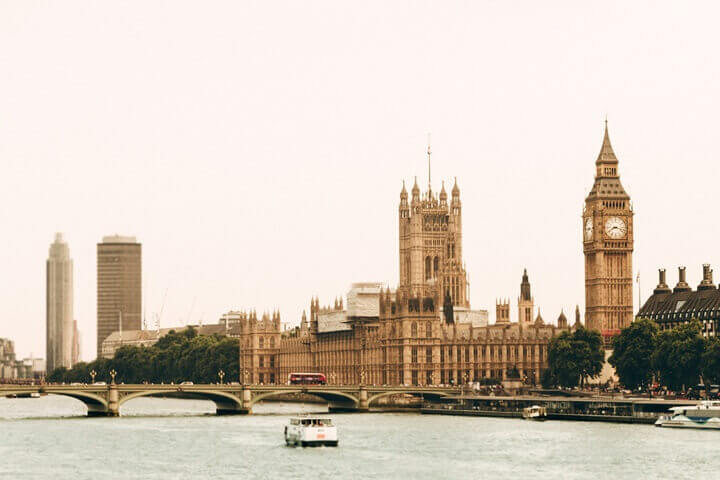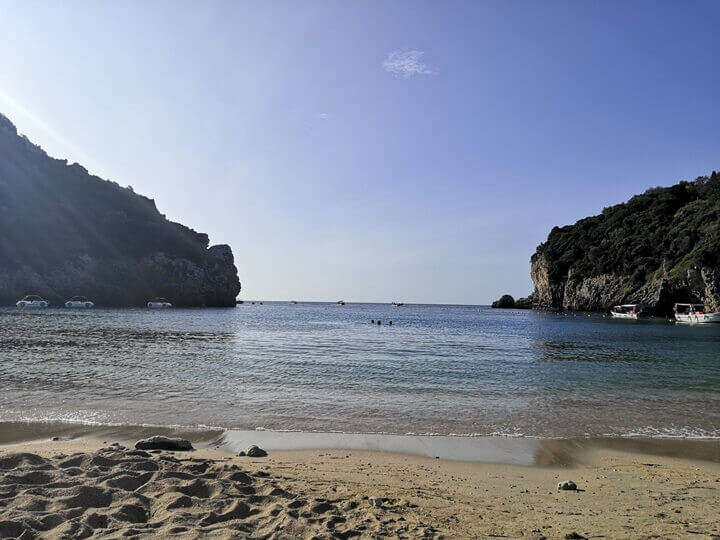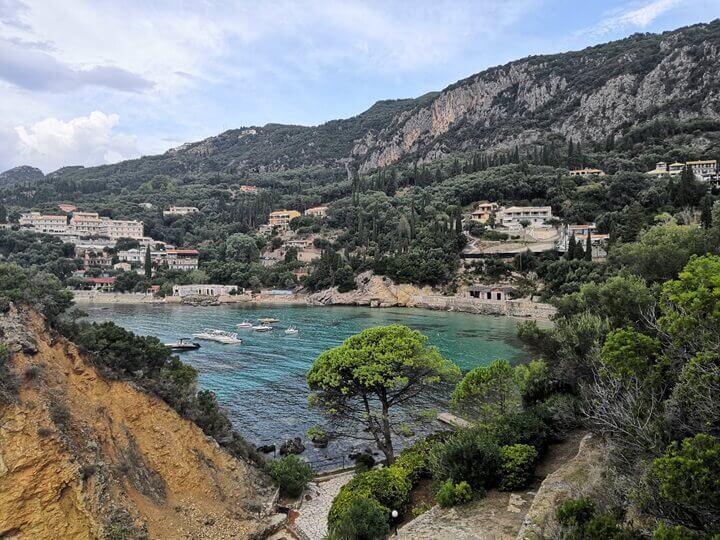What is London Famous for? 55 Things You Need to Know
Wondering what London is famous for? This article will give you the lowdown on the things that make the British capital special.
From unique cultural features and iconic architectural masterpieces to world-class museums and amazing shopping opportunities, these are just some of the things that attract visitors to London.
Although I currently live in Manchester, I’ve been fortunate enough to visit London myriad times, for both work and leisure. It’s easily one of my favourite cities in the world.
In this article, I wanted to go beyond just the famous sites like Big Ben or Buckingham Palace. From being one of the world’s financial centres that also attracts dodgy money, to serving as a setting for famous novels, London is a multi-faceted, complex, and utterly fascinating city to explore.
Without further ado, let’s jump into the many things that London is famous for.
Disclosure: Some of the links below are affiliate links, which means that at no additional cost to you, I may earn a small commission if you click through and make a purchase. Please note, I only recommend products and services that I know and love. Read full Privacy Policy here.
55 Things London is Famous For
Unique Features of London Life
1. Diversity and Multiculturalism
When it comes to diversity and multiculturalism, few cities can compete with London. Nearly a third of the city’s population originates from overseas, from all corners of the globe. Hundreds of languages are spoken across the expansive area of Greater London.
Visitors to London are bound to experience the city’s diversity simply by visiting different areas. Different communities tend to congregate in various parts of the city, bringing with them their national foods, shops, and places of worship.
This diversity has helped create an amazing selection of global restaurants and shops that both Londoners and visitors to the city have at their disposal. No other UK city can match the depth and breadth of London’s global offerings.
2. River Thames
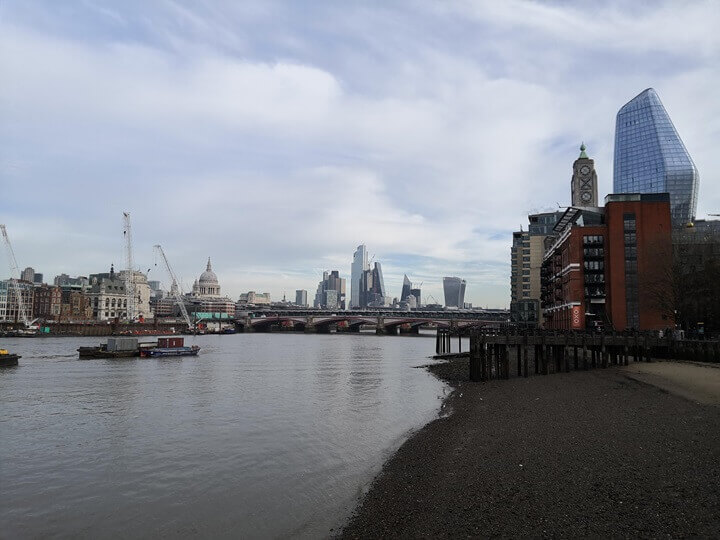
One of London’s most famous features is the River Thames that runs through its heart. It is the second longest river in the UK that starts at Thames Head in the picturesque Cotswolds and flows into the North Sea.
Despite its murky colour, it is actually one of the world’s cleanest rivers that flows through a major city. It wasn’t always the case though as until the late 60s, due to the way the sewage system works, it was so polluted, nothing would be able to survive it.
One way to enjoy this famous river is to walk along the Thames Path. This 128-kilometre-long path starts at the source of the Thames in the Cotswolds and ends in Woolwich in East London.
The path will take you through many picturesque towns and showcase some of London’s greatest sights. Don’t worry, you don’t need to tackle the whole path at once – you can simply focus on the sections that interest you the most.
3. Bad Weather
One not-so-positive thing that London is famous for is its bad weather. Many people associate the city with endless rain, fog, and coldness. Although there is some truth to that, I don’t think the weather in London is as bad as some say.
London, and the UK in general, has a mild climate, meaning that it doesn’t experience extreme heat or cold. In the summer, with the exception of an occasional heatwave, the average temperatures in London fluctuate between 13°C and 23°C (55°F – 73°F).
In the winter months, the temperatures range between 4°C and 9°C (39°F and 48°F). So, it’s hardly the Arctic Circle.
As for the rain, London receives on average 23.8 inches of precipitation a year. This is comparable to other European cities and significantly less than other popular destinations like New York.
London is also known for its fog, which was a feature of local life a few decades ago. However, thanks to regulations on air pollution and improvements in heating technologies, the air quality has drastically improved, so thick fogs are not common anymore.
4. Financial Centre
London is famous for being one of the leading financial centres in the world. New York is London’s key competitor in terms of the size and significance of the industry.
The capital is home to numerous British and international financial institutions. Many of these are located in the historic area of the City of London, also known as the Square Mile, and the ‘newer’ business district of Canary Wharf.
With their glass and steel skyscrapers, these areas offer a very different feel to other parts of London. The new architecture there reflects the concentration of power, wealth, and influence.
Personally, I love the contemporary feel of Canary Wharf and have visited it many times for work and leisure. However, I’ve heard other people say that it’s quite sterile and not really ‘London’. To each their own, I suppose.
5. Dodgy Money
London’s vast financial industry has developed a somewhat notorious reputation because certain sectors have provided avenues for corrupt individuals to launder their dubious money, especially through property in prestigious areas like Knightsbridge and Mayfair. The city is considered the capital of dirty money and has been dubbed the ‘London Laundromat’.
There have been numerous discussions about shutting down the ‘laundromat’, but in reality, there is currently limited political will to undertake such measures. This is likely because the political class benefits significantly from this arrangement as well, but this is not the place to delve into the intricate paths of corruption.
As a visitor to London, you are highly unlikely to encounter this aspect of local life directly. However, if you pay attention, you might notice that in some areas, residential buildings are essentially empty.
I’ve seen this while visiting the beautiful area of Highgate. There was an entire street where many gorgeous houses appeared abandoned. Signage in different languages implied that their owners are overseas, and the properties serve as vaults for their wealth.
6. It Is Ridiculously Expensive
London is also notorious for its extremely high expenses, especially regarding housing costs. Although other cities such as New York and Hong Kong have surpassed London in this dubious competition, it remains one of the most expensive cities in which to live and work.
Dodgy money, alongside more legitimate overseas investments, has inflated prices in premium areas, but that’s not the entire story. The recent economic conditions and government policies, including historically low interest rates, quantitative easing (i.e., printing money), and a limited supply amid ever-increasing demand, have led to price increases across the city.
As a visitor, you won’t need to worry about sky-high rents or mortgage repayments. However, hotel prices in London also bite. For example, to stay relatively centrally in the city, you can expect to pay between £150 and £300 per night at a mid-range hotel.
Truly luxurious hotels will set you back anywhere from £500 to £1,200 a night, and that’s not the upper limit. Transport, food, and activity costs can also add up quickly.
7. Pubs
One of most famous features of London life are pubs – short for “public houses” – where people get together to socialise and enjoy a drink. The capital has a huge selection of pubs to choose from.
Nowadays, the pub scene is firmly dominated by chains like Wetherspoons, that despite sameness, are popular due to their affordability. People complain about them, but as long as the general public continues to support them with their wallets, they are going to thrive.
However, there still a few independents you can seek out for a more unique experience. From traditional places to enjoy a pint to Michelin-starred institutions that serve delectable food and offer high-quality service.
8. Red Double Decker Buses
The ubiquitous red double-decker buses are a London icon. Although other UK cities, like Manchester, and even other countries, have double-decker buses, those in the British capital are uniquely red.
Double-decker buses were introduced in London in the mid-19th century. Originally, the bus colours varied to identify different routes. However, as the transport system became more consolidated and organised, red was eventually adopted as the official livery for London buses.
Today, red double-decker buses remain a popular and affordable form of public transport. A single journey costs £1.75 (US $2.20), regardless of the travel distance.
Personally, I prefer the Tube, but the bus is convenient for short journeys. Plus, if you sit on the top deck, you can enjoy a bit of sightseeing.
Alongside the official Transport for London buses, visitors can also enjoy hop-on, hop-off tours on tourist double-decker buses that travel to popular sites in the capital and offer audio commentary, allowing you to learn more about the city’s history.
You can book a trip on the hop-on, hop-off bus in advance on Get Your Guide.
9. London Underground
Another form of public transport that has become a London icon is the underground rail network, also known as ‘the Tube’. It is one of the best ways to get around, covering many parts of the city as well as nearby counties such as Essex.
There are currently 11 Tube lines to choose from, divided into nine zones. Central London, where some of the capital’s most famous sites are located, is in Zone 1. The bigger the zone number, the further it is from the city centre.
The cost of travel on the Tube depends on the distance and the time of day you travel. Peak times and longer journeys will naturally cost more, with fares starting from £2.70 (US $3.40) per adult.
You can pay for your journeys with an Oyster card or a contactless bank card. If you are using the latter, be sure to check if you will incur foreign transaction fees. It’s possible to pay with cash, but it is significantly more expensive and therefore not recommended.
10. Black Cabs
Black taxis, or cabs, are ubiquitous in London and have become a local cultural symbol. Also known as Hackney carriages, their name originates from the old horse-drawn carriages that were common until the mid-19th century.
Petrol cabs took over in the 20th century and became almost exclusively black after World War II, when this was pretty much the only colour in which they were sold.
In the 1950s, the Austin FX4 model, which served as the prototype for the modern black cabs, was introduced to the streets of London. It remained the main taxi vehicle for forty years, mainly because it was expensive to replace.
Today, visitors can hail a black cab in the street, get one at a designated rank, or book one by phone. Black cabs have a taxi sign on top that gets illuminated when they are available for passengers.
Black cabs are metered, and the cost of your journey will depend on how far you travel. The minimum fare is £3.80 (US $4.80). The Transport for London website offers some good guidance on how much you might pay for different journeys.
11. Red Phone Boxes
Red phone boxes are a common sight in London, and you will find them in many parts of the city. Although they are not used as much as they were in the past, they remain a popular spot for photos.
The original red telephone boxes, the K2 cast iron kiosks, were created by Sir Giles Gilbert Scott in the 1920s. As these were heavy and expensive, a new model, the K6 Jubilee Kiosk, was introduced in 1935 and spread all over the country.
Unfortunately, in the 1970s and 1980s, as home lines became more common, the phone boxes began to show their age and became targets for vandalism. Many of them had to be removed.
Thankfully, they did gain listed building status, which has allowed some of them to remain in place, adding a traditional charm to the areas where they still stand.
12. The Championships, Wimbledon
London is famous for being the home of The Championships, Wimbledon. Also known as Wimbledon, it is the oldest and one of the most prestigious tennis tournaments in the world.
Launched in 1877, it ranks alongside the Australian Open, the French Open, and the US Open as one of the four iconic Grand Slam championships. Wimbledon also plays a crucial role in London’s social calendar, offering an opportunity to spot celebrities, including members of the Royal Family.
Anyone can attend, but securing tickets is no easy feat. You can apply for them through an online public ballot. If you are allocated tickets, you’ll need to complete the purchase within a few days. Prices vary depending on the day, court, and seating options.
Alternatively, you can join the famous Wimbledon queue on the day of the event, as additional tickets are released then. Be aware that this might involve overnight camping.
13. East Enders
“EastEnders” is one of the most-watched soaps set in London. It has been airing since 1985 and has even made its way to international screens. You could even watch it on Sky when I was living in New Zealand.
The show follows the lives of residents of Albert Square in the fictional borough of Walford in London’s East End. Although I’m personally not a huge fan, the show was groundbreaking when it started, as it showed a side of British life that wasn’t often broadcast on television.
The show was also not afraid to explore, with varying degrees of success, controversial and challenging topics. Ultimately, it is supposed to be a reflection of daily life. However, with the ever-growing prices of property in London’s East End, would the characters even be able to live there nowadays?
Famous London Attractions
14. Big Ben
Big Ben, a nickname for the Elizabeth Tower at the Palace of Westminster, is one of London’s most iconic landmarks. The nickname actually refers to the bell within the clock tower, which weighs an impressive 13 tonnes.
The clock tower, along with the rest of the Palace of Westminster, was constructed in the mid-19th century after the original palace was destroyed by fire. Since then, its precise timekeeping and regular chimes have become an integral part of London life.
Visitors to the city can enjoy views of this iconic clock tower from outside or join a guided tour that takes you up the tower to see the famous bell. To join the tour, you must be able to climb 334 steps unaided.
Booking your spot is essential, as these tours are very popular. Ensure you book early to secure your place. You can reserve your spot here.
15. Houses of Parliament
The Palace of Westminster, which encompasses Big Ben, is also the seat of the UK Parliament. Consequently, it is often referred to as the Houses of Parliament.
As previously mentioned, the building that you can see today was erected in the mid-19th century. Nonetheless, this location has served as a hub for religious and political activities since at least the Middle Ages.
Today, the Houses of Parliament are made up of the House of Commons and House of Lords. You can learn about the history of the building and the workings of the UK democracy by joining a guided tour.
You can also watch political debates, Prime Minister’s Questions, and committee hearings from public galleries in both House of Commons and House of Lords. Visitors can attend these free of charge.
16. Westminster Abbey
Located right next to the Houses of Parliament is another iconic London landmark, Westminster Abbey. Recognised as a UNESCO World Heritage Site, the Abbey remains an active place of worship and the venue for royal coronations and other official ceremonies.
The Abbey’s origins trace back to 960 AD, with the current Gothic-style edifice erected in the 13th century. It has hosted religious services for over a millennium. You can attend these for free.
Westminster Abbey also serves as the final resting place for a myriad of historical figures, from monarchs and prime ministers to cultural luminaries such as Geoffrey Chaucer and Charles Dickens.
Visitors are welcome to explore the Abbey’s splendid interiors – tickets can be booked here. I also recommend joining a guided tour so you can learn about the significance of this historic site.
Here a couple of options to choose from:
17. St Paul’s Cathedral
No article on what London is famous for would be complete without mentioning St Paul’s Cathedral. Designed by the legendary architect Christopher Wren in the late 17th century, the cathedral is a prominent feature of the city skyline.
As it is still a working church, the seat of the Diocese of London, you can attend a service there free of charge. If you prefer to simply enjoy its incredible architecture and breath-taking views from its dome, book a sightseeing ticket online.
Those who would like to learn more about the architecture and history of St Paul’s Cathedral can join a guided or self-guided tour. Some are free, while others require a fee. You can see the available tours on the cathedral’s website.
18. The London Eye
The London Eye is one of the capital’s most well-known tourist attractions, located on the South Bank of the Thames. Although it’s somewhat of an expensive tourist trap, it could be a fun way to enjoy amazing views over the city.
The London Eye is the tallest cantilevered observation wheel in Europe and features 32 glass passenger capsules, one for every London borough. The ride is slow, allowing for ample photo opportunities and landmark spotting.
This attraction can get quite crowded, so be sure to book your tickets in advance on the London Eye website. Buying online is significantly cheaper than purchasing tickets at the door.
19. Tower of London
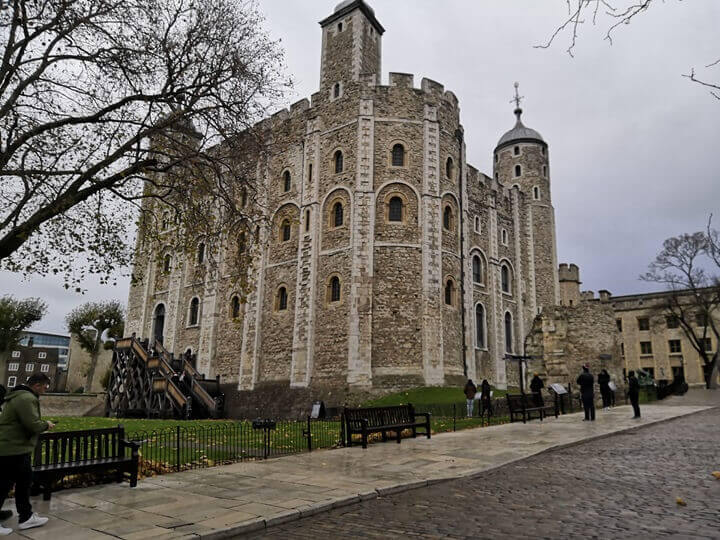
The Tower of London is easily one of the capital’s most famous attractions. Located on the bank of the River Thames, this historic castle and UNESCO World Heritage Site was founded in 1066 by William the Conqueror.
Over the centuries, it has served as a fortress, a royal residence, a prison, a place of execution, an armoury, a mint, and even a zoo. The Tower’s prison has held many historical figures, some of whom were executed there as well.
Another highlight of the Tower of London is the iconic Crown Jewels. This collection comprises over 23,000 gemstones and 100 ceremonial objects of cultural and religious significance, including the coronation regalia. Some of the items are still used in royal ceremonies today.
If you are planning on visiting the Tower on your next trip to London, I highly recommend joining a Yeoman Warder tour. Yeoman Warders, also known as Beefeaters, will provide you with an engaging overview of the Tower’s history and its famous prisoners.
20. Tower Bridge
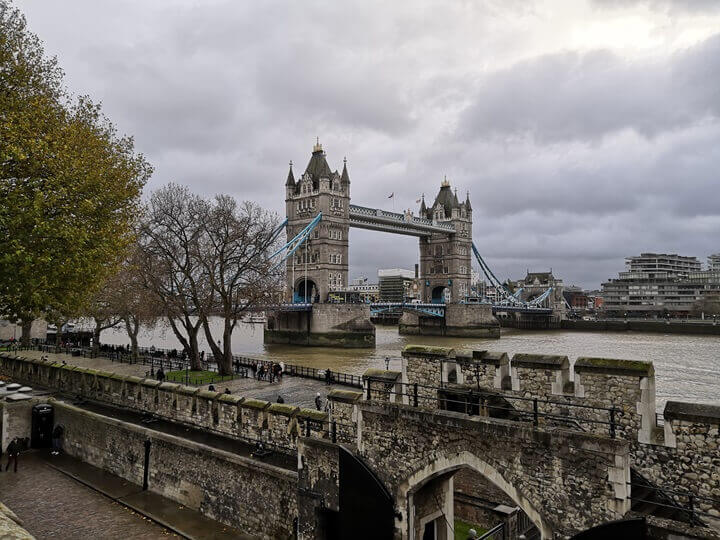
Tower Bridge, crossing the Thames, is one of London’s most iconic landmarks. Built in 1894, its towers complement the look and feel of the nearby Tower of London.
Tower Bridge is a movable, drawbridge-style bridge, meaning that its central leaves (bascules) can open to make space for bigger ships travelling along the river. However, since ship traffic on the Thames has reduced from the Victorian era, the bascules are not drawn up as often.
The bridge is a popular tourist attraction as it boasts two high-level, glass-clad walkways offering panoramic views over this busy part of London. There is also an exhibit featuring stories from Tower Bridge’s past, bringing its history to life.
You can book your tickets for this attraction here.
21. Buckingham Palace
Another famous spot in London is Buckingham Palace, the official residence and administrative centre of the British monarchy. Located within the tranquil Green Park in the heart of central London, it continues to host many royal events and ceremonies.
Throughout the summer months, and on select dates in winter and spring, you can visit the State Rooms of the Palace. Check available dates and book your tickets on the official Palace website.
Many visitors to London also enjoy the Changing of the Guard ceremony, also known as Guard Mounting, that takes place outside the palace. This display of pageantry involves the New Guard taking over the responsibilities of the Old Guard, accompanied by music from a military band.
The ceremony is free to watch and takes place at 11:00 on Monday, Wednesday, Friday, and Sunday, and daily during the summer. Note, this schedule is subject to change.
22. Hyde Park
Despite its size and density, London boasts a wealth of green spaces, with Hyde Park being one of the most famous.
The largest park in central London, Hyde Park features manicured lawns perfect for picnics, wooded areas, and tranquil lakeside paths. The park also hosts various events throughout the year, from the BST Hyde Park music festival to the festive Winter Wonderland event.
Hyde Park is also home to the iconic Speakers’ Corner, located in the northeast corner of the park. This public spot is dedicated to free speech, and on Sunday mornings, anyone can take the space and give a speech on various topics, as long as they are legal.
Be sure to visit Hyde Park on your next visit to London. It offers a wonderful respite from the busy city life.
23. 10 Downing Street (Prime Minister’s Office)
Another famous spot that London is famous for is 10 Downing Street, the official residence and office of the British Prime Minister since 1735. It is the place where many important decisions that have directed the nation have been taking place.
Located just off Whitehall in the central neighbourhood of Westminster, Number 10’s unassuming facade doesn’t allow you to appreciate the actual size of the place. It incorporates three buildings and contains around 100 rooms.
There is no public access to 10 Downing Street. Visitors to London can only see it from a distance, as walking up to it is not permitted either. As you walk along Whitehall, you will spot a heavily-guarded gate on the left-hand side, where you might catch a glimpse of the famous building.
24. The Shard
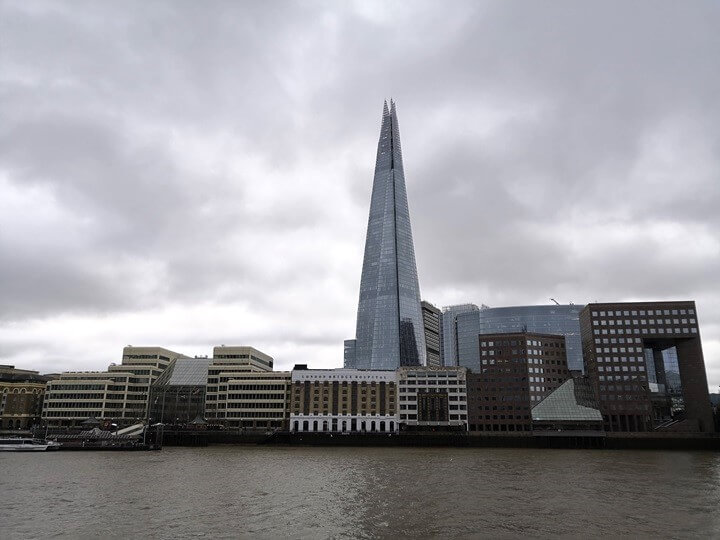
Although London is famous for its historic architecture, it also boasts some outstanding modern buildings that have become unofficial symbols of the city. The Shard, a supertall skyscraper located in Southwark on the south bank of the River Thames, is one of those contemporary landmarks.
Designed by Italian architect Renzo Piano, the concept behind The Shard was to create a vertical city for work and play, inspired by its surroundings. The result is a 72-storey tower, which is one of the tallest in Europe.
The Shard features offices, retail spaces, eateries, and a high-end hotel. Visitors can also enjoy spectacular views over the city from its viewing platforms and an open-air skydeck on the top floor.
You can book your ticket for this experience on the View from The Shard website. It’s a bit of a pricey activity for what it is, but if budget allows, why not?
25. Greenwich Meridian Line
London is also famous for being the home of the historic Prime Meridian of the world. Located in Greenwich, the meridian represents the zero-reference line (Longitude Zero (0° 0′ 0″)) for astronomical observations.
All other places on Earth are measured in terms of their distance east or west from the prime meridian. Although the line is very much imaginary, it has helped to build accurate maps of the sky.
Greenwich was chosen as the location for the Prime Meridian in 1884. The reason for this was that many trading maps had already treated it as a prime meridian, and the US used it as such in their own time zone system.
In 1984, every nation agreed on a new prime meridian, the International Reference Meridian, located not too far from the historic Greenwich one.
You can still visit the historic Prime Meridian to learn more about it. It is part of the Royal Observatory incorporated into the Royal Museums Greenwich.
26. Magnificent Cemeteries
This might sound like a strange thing, but London is indeed home to some beautiful cemeteries. They are architectural gems in their own right and destinations for relaxing strolls and quiet contemplation.
There is a group of cemeteries called ‘The Magnificent Seven’ that were established in the 19th century to counter overcrowding at existing parish burial grounds. They are Highgate Cemetery, Brompton Cemetery, Abney Park Cemetery, Kensal Green Cemetery, Tower Hamlets Cemetery, Nunhead Cemetery, and West Norwood Cemetery.
Being the product of the Victorian era, they include some elaborate tombstones and mausoleums and have a distinctly Gothic feel, thanks to them being overgrown.
If you can only visit one, I highly recommend Highgate Cemetery. Located in North London, it features some stunning burial architecture and famous residents, including Karl Marx.
Famous Neighbourhoods
27. Trafalgar Square
Trafalgar Square is one of London’s most famous spots. This iconic square in the heart of the city features elegant period architecture and historic monuments.
The focal point of the square is Nelson’s Column, a towering monument celebrating Admiral Nelson’s victory at the Battle of Trafalgar in 1805. Four bronze lion statues flank the Column.
The corners of Trafalgar Square are marked by four plinths. Three of these are topped with statues of historic figures, but the fourth one is empty. Originally, it was intended to hold a statue of King William IV, but due to financial issues, it was never erected.
Since 1999, the fourth plinth has served as a space for contemporary artworks. You can see what artwork is currently displayed, as well as past commissions, by visiting this website.
28. Soho
Soho is one of London’s most famous areas that attracts both tourists and locals with its entertainment, nightlife, and dining offerings. It is also an area full of fascinating history and transformation.
From being developed as a suburb for the aristocratic class in the 17th century, to a 19th-century exodus of the wealthy due to a cholera outbreak and the growth of entertainment options such as theatres, to becoming a crazy mix of sex industry, music bars, and film production in the 20th century.
Soho underwent significant gentrification in the 1980s, although some remnants of its seedier past remain. However, today, it’s a buzzing, fun, and happening area that is home to music clubs, smart eateries, and theatres.
Soho is also home to the iconic Carnaby Street, which was the hotspot for youth fashion in the 1960s. Today, the street and the surrounding areas are teeming with various shops, from iconic British brands to global chains and independent restaurants.
29. Covent Garden
Covent Garden is another famous entertainment district in London’s West End. Within walking distance of Soho, it is home to world-class museums, theatres, excellent eateries, and exciting shops.
The heart of the neighbourhood is the historic Covent Garden Market and the surrounding piazza, where you’ll find a great selection of independent shops and dining options. For more unique shopping experiences, head to Neal’s Yard and St Martin’s Lane.
Another iconic spot in the area is the Royal Opera House, where you can enjoy ballet, opera, and classical music performances. Those interested in the city’s history should also add the London Transport Museum to their itinerary. It’s a great place to learn about how local transport has been integral to London’s epic growth.
30. Chelsea
One area known around the world for its association with wealth is Chelsea. Located in southwest London, it has been attracting affluent residents for centuries.
Today, the area is home to investment bankers, wealthy American expats, celebrities, and the global uber-rich whose money is not always clean. However, even if you don’t fall into any of these categories, you can still enjoy the area.
Chelsea boasts beautiful architecture and quiet garden squares, which you can enjoy on a relaxing stroll. There is also a great selection of upmarket cafes, restaurants, and shops to while away an afternoon.
There is even a reality TV programme in the UK called ‘Made in Chelsea’, which follows the lives and dramas of young and wealthy Chelsea residents. However, rumours have it that some of them couldn’t actually afford to live in Chelsea.
London’s Famous Museum and Art Galleries
31. British Museum
London is famous for its epic museums, with the British Museum undoubtedly being the jewel in the city’s crown. Located in the smart area of Bloomsbury, it was the first public national museum in the world.
The British Museum’s collections, featuring a staggering eight million objects, cover the history of human cultures from around the world. From ancient Egypt and the Roman Empire to Asian art and 20th-century Europe, and everything in between, there is so much to discover at the museum that one visit is unlikely to be enough.
Entry to the museum is free, although it is still advised to book your free ticket in advance on the British Museum’s website. Note, some temporary exhibitions may require a fee.
32. Natural History Museum
The Natural History Museum is another famous museum in London. Situated in South Kensington, the museum’s incredible collection, comprising millions of specimens spanning millennia, explores the history of life on Earth.
From dinosaurs and fossils to human evolution, space exploration, and both local and exotic wildlife, the museum boasts a wide range of fascinating exhibits to suit every taste. Additionally, the museum’s Victorian building is an architectural masterpiece in its own right.
General admission to the museum is free. You can book your free ticket on the official website. Some temporary exhibitions may require a fee.
33. National Gallery
Located in Trafalgar Square, the National Gallery is one of London’s most famous art museums. Its impressive collection of European masterpieces, featuring over 2,300 works, attracts tens of thousands of visitors every year.
Whether you prefer Renaissance artists such as Raphael and Leonardo da Vinci, the Dutch Golden Age works by the likes of Rembrandt, or 19th-century Impressionist art, you are sure to enjoy a trip to this gallery.
Alongside the permanent collection, the Gallery hosts temporary exhibitions and events. You can check what’s currently on here. Entry to the gallery is free, although some temporary exhibitions may require a fee.
34. Victoria & Albert Museum
Another cultural institution that London is famous for is the Victoria and Albert Museum (the V&A). Named after Queen Victoria and her consort Prince Albert, it is the largest museum of decorative arts and design in the world.
Although there are now multiple outposts of this museum in London and beyond, the original V&A is located in South Kensington. The collection is truly vast, including everything from fashion and interiors to ceramics and photography, as well as fine art and architecture.
General admission to the museum is free, and booking is not required.
Iconic Cultural Sites and Events
35. West End Theatre
London is famous for its incredible theatre scene, covering pretty much all types of performance imaginable. From cutting-edge fringe theatre to blockbuster musicals and everything in between, there is something for every taste.
The West End in Central London has an especially high concentration of theatres, with nearly 40 to choose from. I’ve been fortunate enough to visit a few, including the Prince of Wales Theatre and the Adelphi Theatre.
If you love theatre, I highly recommend making a trip to the West End part of your next visit to London. The Official London Theatre website is an excellent starting point to see what’s on.
Theatre tickets, especially for big musicals, can be quite expensive. However, I’ve discovered that there are often sales and special offers available for some performances that you can take advantage of.
36. Shakespeare’s Globe Theatre
A London theatre that deserves a special mention on this list is Shakespeare’s Globe, located on the South Bank of the River Thames in central London. Although this is not the original Globe Theatre from William Shakespeare’s times, it is a major cultural venue worth adding to your London itinerary.
The present Shakespeare’s Globe is a reconstruction of the original Globe. It was the American actor and director Sam Wanamaker who initiated this ambitious project back in 1970.
Despite continuous challenges with raising funds and replicating the building techniques and materials from the past, the new Globe Theatre opened in 1997. Unfortunately, Wanamaker didn’t get to see its completion as he passed away in 1993.
Shakespeare’s Globe is the place to go to see the Bard’s works performed in an environment similar to what his original audiences would have experienced.
If catching a show is not an option, consider joining one of their guided tours to learn more about the theatre and Shakespeare’s time. You can book your spot on the Globe’s website.
37. Notting Hill Carnival
London is famous for its abundance of cultural events, with the Notting Hill Carnival being one of the most iconic.
The Carnival is an annual three-day festival that celebrates African-Caribbean culture and takes place in and around Notting Hill during the August Bank Holiday weekend. Since its inception in 1966, it has grown to become one of the largest street festivals in Europe.
The festival features a huge, colourful parade, live Caribbean music and street dancing, and attracts a million visitors a year. In addition, the streets come alive with hundreds of food stalls serving dishes from all over the world.
If you would like to experience London in its party mode, be sure to add this event to your itinerary.
38. BBC Proms
The BBC Proms are an iconic eight-week classical music festival that takes place over the summer months, mainly at the Royal Albert Hall in central London, with some additional events across the UK.
It has been part of London’s cultural event calendar since 1895. The BBC took over in 1927 and has broadcast it since then. The programme includes symphonic and choral pieces, newly commissioned music, chamber concerts, talks, and more.
The most iconic event of the festival is the Last Night of the Proms, which takes place on the second Saturday in September. It features popular classics and British patriotic pieces. This event is very popular, and tickets are highly coveted.
39. Live Music Scene
London is famous for its incredible music scene, which is easily one of the most exciting in the world. Whether you are into jazz, rock, electronic, or pop, there is a music venue catering to pretty much any taste.
From live music bars to rowdy clubs to huge arenas, you can experience music performances of various formats and scales. With such a variety of spots on offer, it is not surprising that the city has produced many iconic music artists.
The Rolling Stones, The Clash, David Bowie, and Led Zeppelin all started their careers in London. More recently, artists like Adele, Coldplay, and Dua Lipa have found stardom around the world.
40. Wembley Stadium
Among football fans, London is famous for being the home of Wembley Stadium, one of the largest sports arenas in Britain. The current stadium is a 2007 replacement for the original Wembley Stadium that operated between 1923 and 2003.
Located in northwest London, Wembley hosts major football matches, including the FA Cup Final. Alongside football, Wembley is also used for other sports, including rugby, and as a music venue for international artists.
You can learn more about this iconic venue and visit areas that are often off-limits to regular eventgoers by joining a guided tour of the stadium. Book your ticket on the official tour website.
41. Live Comedy
London is also famous for its exciting comedy scene, with arguably some of the best comedy clubs in the world calling the city home. From iconic stages in the heart of the city to small affairs in local pubs, there are comedy experiences of all shapes and sizes to choose from.
Comedy venues are scattered all around London, so wherever you are, chances are you’ll be able to easily find a great spot to have a good laugh. The current hot spots include the Backyard Comedy Club in East London’s Bethnal Green, The Bill Murray in Angel, and Downstairs at the King’s Head in Crouch End.
For something different, consider checking out The Boat Show, a comedy club on water. Located in the heart of London, this unique venue offers a programme of rising stars and established comedians.
London’s Shopping and Markets
42. Oxford Street Shopping
Oxford Street, a bustling thoroughfare in central London, is one of the most famous streets in the capital. It’s renowned as a shopping destination and houses department stores like Selfridges, international brands, and numerous gift shops.
There have been numerous discussions about the decline of Oxford Street, as some fine shops close and are replaced with rather underwhelming options, such as the ubiquitous American candy stores. However, Oxford Street remains extremely busy and continues to attract millions of tourists every year.
Personally, it’s not my favourite place to visit, as most of the shops there can be found elsewhere. Nevertheless, I do believe it’s worth visiting if you’ve never been before and would like to understand what the fuss is all about.
43. Harrods
Located in the ultra-wealthy area of Knightsbridge, Harrods is one of London’s most iconic department stores. Although it is actually owned by the state of Qatar, Harrods still remains a local shopping icon.
It opened its doors in 1824 as a small general merchant store, mainly selling tea and groceries. However, over time, it evolved into a more significant establishment and eventually moved to its present location.
Today, Harrods is the place to go for designer gear, jewellery, watches, luxury homeware, and tech. There is even a souvenir section offering affordable mementoes from your visit.
If you are not interested in shopping, don’t worry. Harrods boasts an extensive food offering, including a high-end food emporium bursting with delicacies for all tastes, and a selection of restaurants and bars.
44. Fortnum & Mason
Another famous shopping destination in London is the iconic Fortnum & Mason department store. Located in the upmarket St James’s area of West London, it is the place to go for luxurious delicacies, homeware, and fashion.
Fortnum & Mason was established in 1707 by William Fortnum and Hugh Mason. Over the centuries, the brand has expanded and now boasts additional stores in both London and Hong Kong.
However, I highly recommend a visit to the original building on Piccadilly. It boasts beautiful architecture and traditional, old-world interiors. Alongside shopping, visitors can enjoy afternoon tea at the Diamond Jubilee Tea Salon or join a cooking masterclass at the Food & Drink Studio.
Personally, I love the excellent selection of teas at the store and think it’s a great souvenir, as Fortnum & Mason’s teas are always beautifully presented. Also, be sure to try their legendary chocolate truffles.
45. Borough Market
Borough Market in Southwark is one of London’s most iconic foodie spots. It is home to over 100 stalls, shops, stands, and bars serving high-quality local and international food and drink.
There has been a market in this area for about 1,000 years, and the present building has been in operation since 1756. Whether you’re after some fresh ingredients for home cooking or a delicious meal, you are sure to find something to satisfy your palate.
From mouth-watering British cheeses to European delicacies and Asian street food, the food offering at Borough Market covers pretty much everything under the sun. If you would like to have a sit-down meal, there are plenty of fantastic options as well.
I especially recommend Mallow, a plant-based eatery with an excellent all-day menu. The last time I was there, I tried the Black Forest chocolate pancakes, which were indulgent but oh so good.
46. Savile Row
Savile Row is a famous street in London’s Mayfair, loved by those who value bespoke tailoring. This name is synonymous with high-quality, classy, and bespoke menswear.
The street was gradually constructed between 1731 and 1735, but tailors only started moving in at the end of the 18th century. Their trade continues to grow from strength to strength, thanks not only to the quality of their work but also to the high concentration of wealthy residents in the area.
Today, there is still an array of bespoke tailors where you can have your perfect suit created. However, it is not a cheap option. Nonetheless, there are now retailers that offer high-quality, ready-to-wear designer clothing, which provides a more affordable alternative.
47. Portobello Road Market
One of London’s most famous markets, attracting visitors from all around the world, is Portobello Road Market in Notting Hill. It is known for its extensive selection of antiques, but you can also shop for food, clothes, jewellery, and bric-a-brac there as well.
The market is open from Monday to Saturday, with the latter being the main trading day featuring the most vendors. It operates between 8 am and 6 pm, although some traders may have shorter hours of operation in winter.
As Portobello Road Market is a tourist destination, it is always busy. Unsurprisingly, Saturdays see the most foot traffic, so it might be worth getting there early to beat at least some of the crowds.
London’s Famous Residents: Real and Fictional
48. Sherlock Holmes and Baker Street
London is also famous for being the home of the iconic fictional detective Sherlock Holmes. Sir Arthur Conan Doyle’s famous character resided at 221B Baker Street, a fictional address at the time, and worked at various locations across the city.
Fans of the detective can step into his world by visiting the Sherlock Holmes Museum, which has adopted the 221B Baker Street address in Marylebone. The museum has recreated the sleuth’s townhouse, including his study.
While the museum’s setting allows you to imagine what Sherlock Holmes’ life was like, it also provides an authentic representation of a Victorian house. Additionally, the museum shop sells fantastic puzzles that would delight the detective himself.
49. Jack the Ripper
Although not at all a positive character, Jack the Ripper is one of the city’s most infamous historic residents, who has come to represent the dark side of Victorian London.
He was a serial killer operating in the deprived area of Whitechapel in London in 1888. “Jack the Ripper” is not his real name, but his true identity remains unknown as he was never captured.
Jack the Ripper killed at least five women, who were supposedly prostitutes, but more recent findings suggest that there is a good chance they were not. There were other murders as well, but the police were not able to link them to just one murderer.
The mystery of Jack the Ripper has fuelled many horror films and a subset of the macabre tourist industry. For example, you can learn about the dark side of life in Victorian London and the locations connected to the Ripper on an evening guided tour.
50. Charles Dickens
London boasts a rich and varied literary heritage, with Charles Dickens being one of the most celebrated authors who have called the city home.
Dickens spent many years of his life living in London, and the city serves as the setting for many of his novels, including “Pickwick Papers” and “Oliver Twist.” In a way, London is more than just the place where the action takes place; it is a character in its own right.
Although many of the places featured in the novels are long gone, fans of Dickens’s work can still connect with the author’s legacy while in London. For example, you can learn more about him and his works by visiting the Charles Dickens Museum at 48 Doughty Street in Holborn.
51. Paddington Bear
Let’s now get away from Victorian London. A more modern local character is Paddington Bear. This fictional resident of the city is celebrated for his friendliness, kindness, and good manners.
He is a much-loved character from a series of children’s books by British author Michael Bond. More recently, two films have brought Paddington to the big screen.
Paddington arrived in London from ‘Darkest Peru’ and was adopted by the Brown family, who live in Notting Hill. The stories about Paddington’s adventures in London have won the hearts of children and adults all over the world.
There are many locations in London associated with the beloved bear. This Paddington tour will allow you to visit a few of those. Also, did you know there’s even a Paddington-themed afternoon tea in London?
52. Gangsters
London might be associated with class and pomp, but it also has a dark side, which has produced some notorious criminals. The capital has seen its fair share of famous gangsters, especially between the 1920s and 1960s.
Among the most famous of these dangerous individuals were the Kray twins, Ronnie and Reggie. Their criminal empire in the ’50s and ’60s included armed robbery, racketeering, murder, and assaults.
The brothers were eventually brought to justice, although their legend lives on. They have been immortalised in several films, including a 2015 one with Tom Hardy called ‘Legend’.
Today’s organised crime in London looks a bit different. Gone are the days of local families running their operations. Now, the trade has gone international and presents its own set of challenges (see ‘Dodgy Money’ above).
London’s Foodie Experiences
53. Afternoon Tea at the Ritz
Afternoon tea is a fine British tradition featuring finger sandwiches, scones, and sweet treats, enjoyed alongside quality loose-leaf tea served in beautiful china. You can enjoy this experience in smart hotels, traditional tea rooms, and some restaurants.
Although you can experience the joys of afternoon tea pretty much anywhere in the UK, London boasts one of the most famous versions, offered by the legendary Ritz Hotel in Mayfair. The Ritz is an icon in its own right, associated with luxury and the high life.
The Ritz offers a traditional afternoon tea experience with delicate and perfectly cut sandwiches, fluffy scones, dainty cakes and pastries, and a selection of 20 teas. The afternoon tea is served in a stunning setting and accompanied by a pianist.
This experience is not cheap, at £75 (US $95) per person, but it is more of a special occasion destination anyway. You can book your spot here.
54. Jellied Eels
Jellied eels might not sound that appetising to many nowadays, but they are actually a traditional dish that originated in 18th-century London.
Eels were a common fish in the River Thames, and they were cheap to obtain and prepare. As a result, they became a popular food choice among the poorer areas of the East End. They were traditionally served at shops serving another local staple, pie and mash.
Jellied eels feature chopped eels boiled in herbs and spices, then cooled afterwards. The eels produce enough gelatine to form a soft jelly around the fish. However, gelatine can be added as well.
There are still some traditional pie-and-mash shops in London where you can try jellied eels. However, these are a dying breed, so catch them while you can.
55. Pie and Mash
Speaking of pie and mash, that is another famous dish that originated in East London. The dish consists of a minced beef pie and mashed potatoes served with a green parsley gravy called liquor (no alcohol included).
When this dish came to life, it was originally filled with eels, as they were cheaper than meat at the time, and the liquor was made from the broth used for making jellied eels. Tastes have moved on, though, and now you can find different pie fillings, including vegetarian ones.
There are a few traditional shops where you can try the combo of pie and mash with some jellied eels on the side. Consider M.Manze, a stalwart of these dishes, which dates back to the 19th century. They have outposts in London Bridge, Peckham, and Sutton.
Final Thoughts
So, here you have it. These are some of the many things that London is famous for. As I was writing this article, I felt like I could keep adding new items to the list, but there’s just not enough space for everything.
I hope this article will inspire you to visit London. If you are heading to the British capital for the first time, this guide will help you see the key highlights.
Although London truly is an amazing city, there are other exciting UK destinations worth visiting. Here is the lowdown on the best UK cities to explore and the famous experiences that you can encounter as you travel through this part of the world.
FAQs: What is London Famous for?
There are many things that make London special, owing to it being a truly global city with a long and complex history. It boasts some of the most iconic historic sites in the world, an exciting arts and culture scene, and an incredibly diverse population that helps the local culture to constantly evolve.
London is popular because it offers a wealth of attractions and experiences catering to all types of visitors. Whether you’re into shopping, art, theatre, history, or dining, there is something for everyone there. It is also a popular place to live due to the job opportunities it offers, as well as a fun lifestyle.
London has been an important international city with significant influence around the world for centuries. The aggressive expansion of the British Empire was one of the forces that drove its importance in the past. Today, London remains one of the most significant financial centres in the world, keeping the city relevant on the global stage.
Enjoyed this guide to the things that London is famous? for Bookmark or pin it for later.
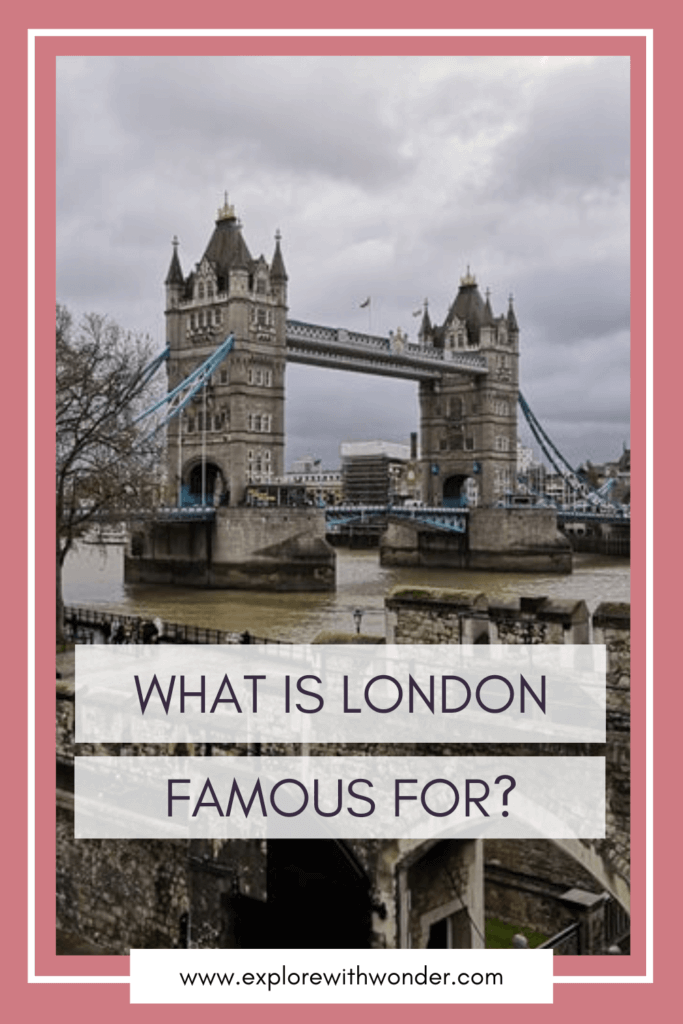
Related Reads: London & the UK
- What is the UK Famous for? 43 Things You Need to Know
- The 19 Best Cities to Visit in the UK
- The 11 Best Things to Do in London for First Timers
- 10 Best Things to Do in York
- How to Spend a Weekend in Manchester: The Ultimate Guide
- How to Spend a Weekend in Liverpool
- One Day in Leeds: The Ultimate Itinerary
- How to Spend a Day in Chester: The Ultimate Itinerary

